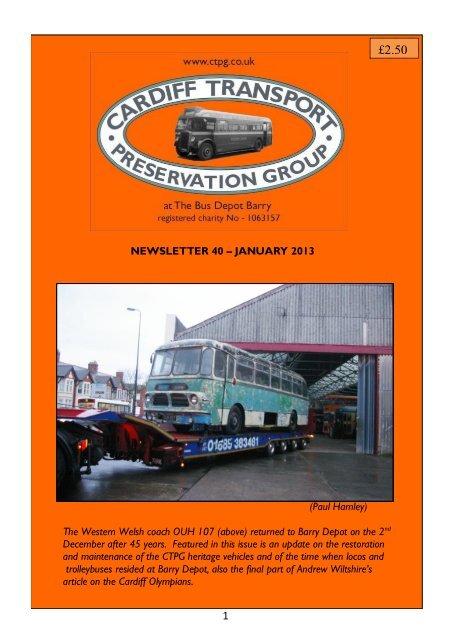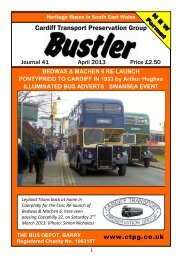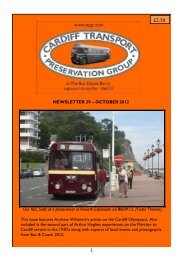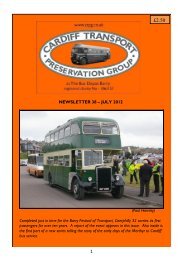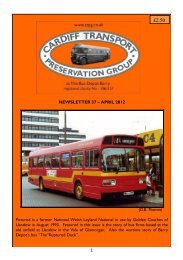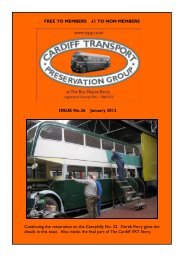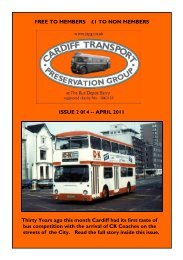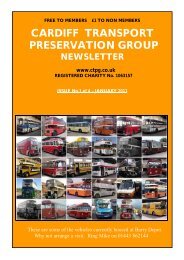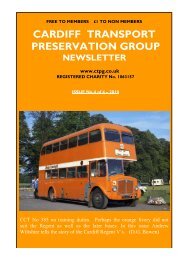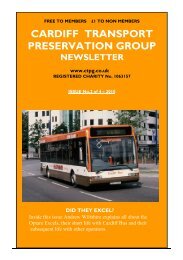You also want an ePaper? Increase the reach of your titles
YUMPU automatically turns print PDFs into web optimized ePapers that Google loves.
£2.50<br />
00<br />
NEWSLETTER 40 <strong>–</strong> JANUARY <strong>2013</strong><br />
1<br />
(Paul Hamley)<br />
The Western Welsh coach OUH 107 (above) returned to Barry Depot on the 2 nd<br />
December after 45 years. Featured in this issue is an update on the restoration<br />
and maintenance <strong>of</strong> the CTPG heritage vehicles and <strong>of</strong> the time when locos and<br />
trolleybuses resided at Barry Depot, also the final part <strong>of</strong> Andrew Wiltshire’s<br />
article on the Cardiff Olympians.<br />
1 1
10 th October 2012; Two Cardiff VRTs meet again! 348 & 359. The latter is a convertible open<br />
top that would be useful to the group. Its condition is currently under review.<br />
Below; 397, the last <strong>of</strong> the batch, was donated to the group during 2012 but was in very poor<br />
condition. Useful parts were removed and the remains sold for scrap. (Paul Hamley)<br />
2
CHAIRMAN’S MESSAGE:<br />
Welcome to the first CTPG newsletter <strong>of</strong> <strong>2013</strong>. I think that we should congratulate Viv<br />
on the continuing quality <strong>of</strong> the newsletters this year, please help to support him through<br />
your articles and photos.<br />
Work has progressed on the fleet with a number <strong>of</strong> winter jobs being completed<br />
positively. TAX 235, our Red and White Lodekka, now has a good vacuum for the<br />
brakes which has been a long standing issue with the bus and we have now sourced a<br />
replacement steering box, which was the other issue. Hopefully we can now return<br />
L358 to the road. The Jones Cub has definitely blown another head gasket. This really<br />
makes the engine block the issue as the head was skimmed after the last problem. We<br />
are considering an engine swap using the spare Leyland 401 engine that we have in store,<br />
this would give the bus a bit more power and resolve the overheating problem.<br />
Early in December, OUH 107 finally arrived back at Barry Depot after an gap <strong>of</strong> 45<br />
years, It was allocated at Barry for the latter part <strong>of</strong> its service life and then 40 years<br />
with its last owner Adkins <strong>of</strong> Upper Boddington (see page 4).<br />
At almost the same time, we were donated Western Welsh 13, TUH 13 the Albion<br />
Nimbus, which has been a resident since the Depot first opened (see page 5). This<br />
brings our Western Welsh collection to six (7 actually at the Depot with 1370) and with<br />
the hope that 177 and 856 will be on the road this year. We also hope that PAX will be<br />
back in blue and ivory by the time that you read this. Other painting jobs to be done this<br />
year include the completion <strong>of</strong> Cardiff 497 and the tidying <strong>of</strong> 434. We always need more<br />
helpers, so please come down on Fridays or Saturdays to volunteer.<br />
I hope that you all observed our buses in the enthusiast press over the last few months<br />
both the Swift and Caerphilly 32 have had either cover or centre spread.<br />
I have recently received confirmation that the relevant Councils will again support our<br />
events. However this year’s Barry rally will not be at Hood Road but will be on Barry<br />
Island, the current thinking being that buses and commercials will park in the old Butlins<br />
site and cars will park on the promenade, make a date in your diaries as we will need<br />
your help;<br />
Barry Festival <strong>of</strong> Transport at Barry Island, on Sunday 9th June<br />
Ebbw Vale Classic Bus Day on Saturday 20th July<br />
Bus & Coach Wales at Merthyr Tydfil Leisure Centre on Sunday 8th September<br />
On behalf <strong>of</strong> myself and the CTPG Committee I would like to wish all members and<br />
readers best wishes for <strong>2013</strong> and good fortunes in whatever you do.<br />
Mike<br />
Tel: 07733 302242<br />
Email : mikeystrad73@btinternet.com<br />
Also keep up to date on our Facebook page<br />
3
THE RETURN OF 107:<br />
Late on a dark, cold, wet, December Sunday afternoon a long low-loader drew up beside<br />
The Bus Depot in Barry, with a very special vehicle on board. To passers-by it looked<br />
slightly motley, mould covered and paint decayed.<br />
However, the members <strong>of</strong> the Cardiff Transport Preservation Group who volunteer in<br />
heritage bus restoration saw it as a dream coming true. A genuine former Western<br />
Welsh luxury touring coach <strong>of</strong> the late 1950s is back home at Barry after 45 years.<br />
Mr. Adkins bids farewell to his old coach.<br />
The coach was new in March 1958,<br />
a AEC Reliance with a Harrington<br />
Wayfarer body built in Hove,<br />
Sussex with 39 seats. It was one <strong>of</strong><br />
a small fleet bought by Western<br />
Welsh for their extended coach<br />
tours. The first coach <strong>of</strong> the<br />
“Capital Class”, it was first<br />
allocated to the Western Welsh<br />
bus depot in Pontypool but it<br />
moved to the Penarth Rd. depot for<br />
private hire and extended tours.<br />
It was moved to Barry depot in<br />
1963, where it continued on private<br />
hire and day tours work until it was<br />
withdrawn in the autumn <strong>of</strong> 1967.<br />
In November 1967 it passed to North’s, a dealer in Yorkshire and was bought by<br />
almost immediately by TW Holling <strong>of</strong> Askern in Doncaster. Four years later it was sold<br />
to JR Buxton, <strong>of</strong> Primethorpe, Leicestershire, but it only stayed six months and went to<br />
DH and DE Adkins <strong>of</strong> Upper<br />
Boddington, Northamptonshire<br />
in January 1972. At Adkins it<br />
saw operation for nearly four<br />
years and was withdrawn in<br />
December 1975.<br />
Luckily, 107 was stored under<br />
cover and it remained out <strong>of</strong> use<br />
for 37 years. Mike Taylor, the<br />
Group’s chairman took a look at<br />
it and in 2012 sealed a deal to<br />
bring it back to its home area at<br />
Barry in south Wales. The body<br />
appears very solid for its age. In<br />
due course we will learn <strong>of</strong> its<br />
mechanical condition.<br />
Safely back at Barry Depot after 45 years.<br />
(further photos on p.27)<br />
4
5
DEREK’S LOG; by Derek Perry.<br />
Titan LNY 903 PD2/12<br />
This bus being our next project we started with the removal <strong>of</strong> the rear N/S lamp<br />
modification, followed by the rear two panels, the corner panels then the O/S panels<br />
along to the cab.<br />
The timber frame under the rear panel has rotted. With the rusted lower eight inches<br />
<strong>of</strong> the inner steel panel cut <strong>of</strong>f a new steel patch was cut and fitted. The timber frame<br />
repaired or replaced, then refitted and painted. A new lower corner timber was cut<br />
from two pieces <strong>of</strong> hard wood then glued and screwed together and fitted. The next<br />
panel was also rusted at the bottom; a new section <strong>of</strong> steel was cut and fitted. The two<br />
smaller next sections had the same treatment, and the bottom timber has also been<br />
replaced. All exposed rear and side panels have been wire brushed and painted.<br />
To fit bolts to the rear and side panels, access was mainly under the stair case, but to get<br />
at the forward two sections we had to remove the side seat swab and that was when we<br />
found the floor panel had been previously repaired with aluminium which had<br />
subsequently corroded, removal was as simple as stepping on it. Further cleaning and<br />
replacing with steel has taken place, followed by the usual paint job.<br />
The cast aluminium step to reach drivers cab has been located in the box <strong>of</strong> parts that<br />
came with the bus, but the wooden support has been badly damaged so a new frame has<br />
been made and fitted by Richard Fitzjohn. The panel on the lower rear corner has been<br />
cut and fitted, but the one above that has been damaged and has a hole in it, so this has<br />
been removed ready for replacing with new metal.<br />
Removal <strong>of</strong> the rest <strong>of</strong> the <strong>of</strong>f-side panels has taken place, as far as the cab. Cleaning<br />
and painting has been carried out. Two new panels have been cut for the rear, the <strong>of</strong>f<br />
side one has been cut to fit in the number plate recessed panel and temporary fitting has<br />
taken place, as the rear lamps have to be obtained before cutting the panels can take<br />
place. The lower corner panel has been cut, shaped, and fitted. The next panel also has<br />
been cut and fitted, one <strong>of</strong> the panels that have been taken <strong>of</strong>f is dented but with its paint<br />
removed, and the dented area cut out to fit the wheel arch we are able to re-use it.<br />
A new panel has been cut to size and shaped to fit the front half <strong>of</strong> the wheel arch, the<br />
next two panels are not in too bad a condition so have been paint stripped and refitted.<br />
Peter Smith has started cleaning the ceiling on the top deck. Paul Gilbertson and<br />
Richard Evans have joined him and they have succeeded in rescuing the surface so that<br />
we will not have to paint it<br />
Looking through the boxes <strong>of</strong> old parts that came with the vehicle, the cable clamp was<br />
rescued cleaned and refitted to hold the heavy cables as they go through the floor.<br />
A floor panel from the same box has been cleaned and re-bolted into place, the<br />
remaining gap has to be filled with a combined wheel arch and wing panel, this is also<br />
available but in a very poor condition, The fitting <strong>of</strong> this panel to the body has entailed<br />
the removal <strong>of</strong> a flat strip from part <strong>of</strong> the curve and a length <strong>of</strong> angle iron curved to the<br />
shape <strong>of</strong> the wheel arch, this is proving tricky but we will get there.<br />
6
A new front panel which has been fitted by the previous owner has had to be removed<br />
to get at the fitting holes for the front wing. These holes are through the next body<br />
panel which does not line up so work is done to rectify this, plus a small patch made and<br />
fitted within the headlamp hole. Alan Poole and I have done most <strong>of</strong> the work on this<br />
vehicle at the moment.<br />
Measurements have been taken and a new panel cut to replace the rear <strong>of</strong> the wing<br />
panel, the inner edge <strong>of</strong> which has been bent over a wire to make a stiff edge as per the<br />
original. Offering this panel up to mark where holes have to be drilled, removing and<br />
drilling, fitting up with bolts in some <strong>of</strong> these holes and further marking has been tricky.<br />
Undercoat and gloss has been applied to the parts that we will not be able to get at<br />
when fitted.<br />
7<br />
Bolting up has now<br />
been done, and cutting<br />
from the outer edge in<br />
and shaping the curve,<br />
wiring the outer edge as<br />
we did with the inner<br />
edge and welding on<br />
small strips to cover the<br />
gaps where the shaping<br />
opened up the cuts.<br />
The old front O/S wing<br />
has been cut in half and<br />
the front half has been<br />
fitted to the vehicle. It<br />
has repair patches<br />
welded on but body<br />
filler will smooth it out. The shaping matches up with the new back end we made,<br />
although four inch short, a new section <strong>of</strong> metal has joined them together OK. A<br />
coating <strong>of</strong> filler applied, rubbed down, followed by further layers plus rubbing down until<br />
the final shaping is obtained. A final timber has been shaped and fitted to support the<br />
lower rear <strong>of</strong> the wing.<br />
Our two new members Daniel Taylor and Gareth Davies, have joined us with this job<br />
and have removed the N/S body panels, cleaned and painted the serviceable inner panels,<br />
we can now see where a few new patches will have to go to finish repairing before the<br />
outer panels can be refitted. Mike Duxbury another new member has started removing<br />
the seats on the top deck, all the beading from the floor, and finally removing the<br />
linoleum floor covering.<br />
We have been looking at the rear panel underneath the emergency door, a patch has<br />
been riveted on centrally looking as if covering a destination board, but nothing shows<br />
on the inside to match, to satisfy every-ones curiosity Daniel and Gareth drilled out the<br />
rivets and removed the patch: low and behold a large tear in the panel, evidently the easy<br />
way out was taken sometime in the past with a patch fitted over the damage.
8
Peter Smith has taken on the job <strong>of</strong> the removal and renewal <strong>of</strong> the complete panel,<br />
this was not easy as this panel tucks under the other panels, plus the emergency door<br />
hinges are bolted through the top edge. When the panel was removed the timber<br />
framing underneath was found to be in good order, apart from the bottom strip being<br />
loose. New screws were fitted and two coats <strong>of</strong> aluminium applied. With the emergency<br />
door <strong>of</strong>f, cleaning and paint removing has been carried out, uncovering a door that is in<br />
very good order. Steel patches have been made and the rear painted before bolting and<br />
riveting on to the N/S inner panels sealer and paint has been applied. On checking the<br />
panels taken from the N/S, only one is in a suitable condition to be refitted.<br />
New aluminium sheets have been purchased, the first <strong>of</strong> these sheets have been cut to<br />
fit the last O/S front panel, the one up to the door. This panel is fitted temporarily as it<br />
will have to be removed later to cut the hole for the drivers step. Two panels have been<br />
cut and fitted to the N/S, starting from the front. Due to the lack <strong>of</strong> room on that side it<br />
has been decided to delay fitting any more until the bus is moved. The two upper deck<br />
front windows have been removed before they fall out as the rubbers were badly rotted.<br />
Mike Duxbury has been<br />
busy on the top deck,<br />
removing the seats and<br />
beadings into storage. On<br />
removal <strong>of</strong> the floor covering<br />
it was found that the adhesive<br />
was still tacky so a couple <strong>of</strong><br />
old carpets were but down<br />
to stop us sticking to it. The<br />
O/S join <strong>of</strong> the upper deck to<br />
the lower is by a length <strong>of</strong><br />
angle iron bolted to top and<br />
bottom, covered with a<br />
timber trim, the timber fell<br />
<strong>of</strong>f uncovering the rusted<br />
angle iron, most <strong>of</strong> which is<br />
serviceable but some <strong>of</strong> it will<br />
have to be replaced, wire brushing and painting has been done to the serviceable section.<br />
The N/S however is totally different having four triangular brackets riveted to the<br />
upper deck and bolted through the floor to the lower deck. The bottoms <strong>of</strong> all these<br />
brackets have rusted away, so new brackets have been fabricated and welded into place.<br />
As our welding equipment was too big and heavy to be manoeuvre up stairs, we had to<br />
improvise; we loaded the welder into the café <strong>of</strong> the fork-lift and lifted it to take the<br />
hoses etc. through the emergency door opening at the rear. The N/S floor also have<br />
curved sections <strong>of</strong> aluminium to support the floor covering into shape up to the side<br />
panels, they also have a shaped top edge to hold the covering, these have been removed<br />
to clean and paint the panels underneath.<br />
9
Alan Poole and I did not want to spend two days standing around on the open day for<br />
the tall ship weekend, so we placed the driver’s door onto the bench and started to<br />
repair same. If visitors looked in we stopped and chatted, if not we carried on working.<br />
After removing the sliding window and frame, we then cut out rusted sections and<br />
replaced them with new metal, welding or screwing as needed. We removed the skin<br />
from the bottom <strong>of</strong> the door, this will have to be replaced with new aluminium and with<br />
this <strong>of</strong>f we were able to repair the bottom edge <strong>of</strong> the frame. Replacing the sliding<br />
window was tricky but has been completed with new wood sections each end. A couple<br />
<strong>of</strong> days well spent.<br />
A door strap had been fitted badly sometime in the past, a block <strong>of</strong> wood has now been<br />
fitted inside as this will support the strap better when refitted. A new piece <strong>of</strong><br />
aluminium has been cut and fitted to the lower section and a hole cut to take the outer<br />
door handle, body filler has been applied to tidy up followed by rubbing down and the<br />
first coat <strong>of</strong> undercoat.<br />
We welcome Richard<br />
Fitzjohn back to the fold his<br />
hip operation has laid him up<br />
for some time and still has to<br />
take things steady. As some<br />
<strong>of</strong> the window frames will<br />
have to be rebuilt he has<br />
made up a wooden jig to<br />
make certain the sizes are<br />
right and the repairs are kept<br />
in shape when we start<br />
welding. The side panels <strong>of</strong><br />
the upper walk way have<br />
been found to be loose and<br />
removal <strong>of</strong> the wood trim<br />
revealed the panels have<br />
rusted away on the lower edges and will have to be renewed. After a little work on the<br />
on the wood frame they should take the new panels ok. Mike Duxbury turned his<br />
attention to the front panel covering the destination board, and finding it loose and<br />
wobbly he removed it completely and took it down to the bench where he proceeded<br />
to put it back together with new brackets and screws.<br />
Paul Gilbertson got busy on the lower deck as many <strong>of</strong> the parts that came with the<br />
bus were stacked inside. The first job was to remove all the body strips, straighten<br />
them a bit, removing all nails and screws and stacking them against the back wall <strong>of</strong> the<br />
garage. Paul removed all hardwood pieces to the wood store. Spare sliding window<br />
frames were removed to number two store, radiator and grill removed to the rear wall,<br />
leaving a clear working area. Buckets <strong>of</strong> water, cloths and hard work have removed the<br />
first layers <strong>of</strong> dirt from the seats. A spray/extraction upholstery cleaner has removed<br />
another layer <strong>of</strong> dirt and dog hairs.<br />
10<br />
Derek Perry Oct. 2012.
OCTOBER MEETING;<br />
Colin Scott gave us a presentation he called “Wonderful Western Welsh” with<br />
anecdotes from his own recollections and some from his recent book “Red, Cream and<br />
a touch <strong>of</strong> Gray”<br />
With the online publicity given to this event we expected to see more members than<br />
the 25 or so that attended. The Western Welsh company holds many memories for all<br />
those aged over 40 and Colin certainly gave his audience many more to ponder over.<br />
NOVEMBER MEETING;<br />
------------------------------------<br />
On this evening we welcomed back our member, Robert Edworthy, who agreed at short<br />
notice to give the group a presentation. His subject, Red & White Services Ltd., is one<br />
close to his heart as he is a font <strong>of</strong> knowledge on this company. Robert is also co-author<br />
<strong>of</strong> a new Red & White history which is eagerly awaited by all enthusiasts.<br />
We were told how John Watts started in business with his brother at Lydney and that<br />
after having been involved in several bus firms in the 1920s, his enterprise developed into<br />
Red & White Services Ltd. in 1930. Robert related to us the history <strong>of</strong> the concern up<br />
to 1950, the year that it was sold to the British Transport Commission. Robert<br />
illustrated his comments with period photographs, many <strong>of</strong> which had not been shown<br />
before.<br />
Thank you Robert, we look forward to you continuing the Red & White story for us in<br />
due course.<br />
DECEMBER MEETING;<br />
The annual Quiz Night was held on 19 th December at the Penarth Conservative Club.<br />
Hosted once more by our Vice Chairman, Chris Taylor, the evening was attended by<br />
about 25, including visitors from the PSV Circle and the South Wales & West Omnibus<br />
Society.<br />
Questions followed the pattern <strong>of</strong> previous years with all forms <strong>of</strong> transport covered.<br />
New this year was a “Brain <strong>of</strong> Britain” section that many found quite difficult.<br />
When asked “What is the length <strong>of</strong> the Queen Elizabeth?” One wag answered “Sixty<br />
years!” As you can imagine, the quiz was not taken too seriously.<br />
Perhaps too many questions were posed this time as our allotted time soon ran out.<br />
Many thanks again to Chris for his efforts, to Nicky Reason for his motoring questions<br />
and to Mike who acted as scorer. Who won? Well it was close with the PSV Circle just<br />
defeating the O.S. team.<br />
11
THE SPANNER AND HAMMER BRIGADE;<br />
by Robert Sparks<br />
This year the spanner and hammer brigade have been trying to sort out some <strong>of</strong> the<br />
mechanical gremlins which have plagued some <strong>of</strong> our vehicles, here is a brief outline <strong>of</strong><br />
what we have been doing.<br />
Ponty No 8; On an outing to Swansea it started having fuel problems on the way back.<br />
1. Fuel lift pump clogged with dirt. Pump cleaned, fuel tank removed and<br />
cleaned out and replaced, new fuel line fitted, new filter and fresh fuel put in and<br />
road tested ok.<br />
Bob gets to grips with Ponty No. 8 (Mac Winfield)<br />
AEC Swift; Ongoing fuel problem.<br />
1. Fuel system totally overhauled. DPA fuel pump removed and checked.<br />
Injectors overhauled. New lift pump fitted with new fuel filters. Some<br />
pipework and connectors renewed and a water trap fitted as original has been<br />
by-passed. Fuel tank drained and fresh fuel put in. Engine valve timing and<br />
tappets checked, fuel injection timing checked and road tested ok.<br />
The next job to do is the engine radiator fan right angle drive unit seal leaking.<br />
Red& White Lodekka; Brake problem and heavy steering.<br />
1. This vehicle has vacuum brakes and when checked it was not producing any<br />
vacuum. We checked the exhauster and found it serviceable, so checked<br />
pipework and connections back to storage tank. The tank was found to have<br />
corroded, so this was removed awaiting a replacement or repair. The steering<br />
seems to be a draglink joint done up to tight.<br />
12
Jones Tiger Cub; Engine cooling problem.<br />
1. Checked engine cooling system and found that expansion tank was blocked.<br />
Unit cleaned out and re-fitted. Thermostat missing, so new one sourced and<br />
fitted. Engine run up but found that it was still blowing water out from tank and<br />
between exhaust manifold joint. Difficult to restart engine as bores seem to be<br />
filling with water. Suspect engine block has some damage to it causing head<br />
gasket not to seal properly. Replacement engine to be fitted when funds<br />
permit.<br />
Down the pit inspecting the cooling system on the Jones Cub.<br />
(V.C.)<br />
Newport Atlantean; Front suspension problem, Front doors u/s and low power.<br />
1. On examination both front road springs clips done up far too tight, these<br />
were slacked <strong>of</strong>f but two had to be made as they broke whilst trying to free<br />
them. Both dampers removed and checked ok. All front shackle pins readjusted<br />
and greased, springs lubricated with mixture <strong>of</strong> old oil and diesel.<br />
(The magic mix <strong>–</strong> takes me back to my apprentice days! Ed.) Fuel system water<br />
trap filter clogged up, this was cleaned and refitted. New fuel filters fitted.<br />
2. Front doors chain link had parted, new pin fitted and lubricated. Road tested<br />
vehicle much improved performance.<br />
Nearly all <strong>of</strong> the running fleet have had their engine oil and filters changed, and various<br />
jobs have been done on other vehicles, we have a list <strong>of</strong> work to do which we hope to<br />
get done over the coming months.<br />
Robert Sparks Dec. 2012<br />
13
TROLLEYS AND LOCOS AT BARRY DEPOT;<br />
At noon on Friday 7 th August 1992 redundancy notices were handed out to nearly 80<br />
employees at Barry Depot and the last outpost <strong>of</strong> National Welsh closed at 6pm.<br />
Over the following two weeks the remaining vehicles and equipment were taken away by<br />
staff <strong>of</strong> Rhondda Buses Ltd. and the depot was boarded up. The receivers for the<br />
company quickly put the site on the market with Henry Butcher & Co.<br />
An application by Hypervalue Holdings to use the main building for storage or retail use<br />
was refused by the Vale Council in March 1993. The following month the site was<br />
purchased by the Council for a reported £250,000, although it seems they were unsure<br />
what they were going to do with a building <strong>of</strong> 19,000 sq. ft. and <strong>of</strong>fices <strong>of</strong> 2750 sq. ft. on<br />
ground with certain restrictions and leased from the British Railways Board.<br />
Over the following 15 years the exact uses <strong>of</strong> the depot are unclear. You would think<br />
that as former Honorary Historian to National Welsh your editor would have kept tabs<br />
on it, but unfortunately not -- mind you I did have a new job and a new wife to occupy<br />
my time! However, with the help <strong>of</strong> Keith Walker and Paul Hulyer <strong>of</strong> Cardiff & South<br />
Wales Trolleybus Project (C&SWTP) and Frank Learner’s Railway Heritage Centre<br />
Booklet (1998), certain aspects <strong>of</strong> this period have become clearer.<br />
In 1993, the Butetown Historic Railway Society was informed they would have to<br />
relocate due to the impending multi-million pound development <strong>of</strong> Cardiff Bay.<br />
Fortuitously, the Vale <strong>of</strong> Glamorgan Council <strong>of</strong>fered a site at Barry Island to the Society<br />
to create a working railway heritage centre. In 1994, the Society by then renamed the<br />
Vale <strong>of</strong> Glamorgan Railway Company Ltd., began the relocation plans to Barry, the first<br />
part being the transfer <strong>of</strong> their locomotives to temporary storage at the former Bus<br />
Depot pending the completion <strong>of</strong> the Barry Island site. These locos had been purchased<br />
from Woodham’s Scrapyard in the late 1980’s for £85,000 with assistance from the<br />
National Heritage Memorial Fund and were later known as the “Barry Ten.”<br />
These were <strong>–</strong> No’s 2861, 4115, 5227,5539,7927,6686,48518,44901,80150 & 92245.<br />
Also stored were some carriages, a footbridge and various other items.<br />
The Company’s working saddle tank “Sir Gomer” was moved directly to the Barry Island<br />
site in 1997.<br />
In 1995, the C&SWTP were given permission to store trolleybuses alongside the locos<br />
at the old Barry Bus Depot. The first to arrive was the Bradford Karrier 704 followed<br />
later by Cardiff BUTs 243 & 262. The trolleybus group were able to perform limited<br />
restoration at the depot. Also about this time the Vale Council were in talks with local<br />
heritage groups (including CTPG) to promote the ambitious Welsh Transport<br />
Experience, however with the loss <strong>of</strong> European grants this scheme soon faded and so did<br />
the access for trolleybus restoration.<br />
Then in1998, it was decided by the Vale Council that the locos should be removed<br />
from the depot. The locos were temporarily moved to Atlantic Trading Estate until the<br />
Barry Island site was ready. The trolleys however, had to be moved to get the locos out<br />
so they were towed out and left on the outside wall <strong>of</strong> the depot.<br />
14
Taken in March ‘98 from the old footbridge, the three trolleys wedged along with railway items.<br />
The three trolleybuses consigned to a five weeks stay along the wall <strong>of</strong> Barry Depot. Sept.’98.<br />
15
Members <strong>of</strong> C&SWTP kept an evening watch on their vehicles while contractors<br />
moved the locos. This position lasted for five weeks before the trolleybuses were back<br />
inside, towed by courtesy <strong>of</strong> Nigel Martlew <strong>of</strong> Hawthorn Coaches and their Leyland tow<br />
truck, although access for restoration was again denied. The two double decks were<br />
positioned over the pits and 243 on the eastern wall near the oil tank.<br />
The trolleybuses were joined by preserved Cardiff double deck buses owned by the<br />
Welsh Industrial & Maritime Museum, namely Crossley 46, Guy open-topper 434, and<br />
Trolleybus 215. This was to be a temporary home for these due to the senseless<br />
demolition <strong>of</strong> the WIMM building at Bute Street. Also stored at the depot was Cardiff<br />
Fleetline 532, owned by the CTPG.<br />
The furniture refurbishing charity Track 2000 later used the building for storage.<br />
Unfortunately, during this time a break-in at the rear <strong>of</strong> the building caused some severe<br />
vandalism particularly to the WIMM vehicles. In 1999, came an application from<br />
Hawthorn Coaches to use Barry Depot for their coach business. This was rejected,<br />
partly due to local opposition claiming a likely return <strong>of</strong> undue noise and pollution.<br />
The vehicles owned by the Welsh Industrial & Maritime Museum along with other<br />
heritage items were eventually moved to storage at Nantgarw and the Cardiff Fleetline<br />
532 was the last bus to leave in 2002 for storage at Wenvoe. The C&SWTP managed to<br />
secure rent on a large barn at Wentloog and in December 2001 trolleybus 243 was<br />
towed there by Cardiff Bus Engineer, Dave Whalley, with the Cardiff Bus ERF recovery<br />
truck while 262 & 704 followed on with the assistance <strong>of</strong> Celtic Recovery.<br />
By the middle <strong>of</strong> the decade the depot was empty (apart from a family <strong>of</strong> pigeons) and<br />
after a long legal journey the lease <strong>of</strong> the depot was granted by the Vale Council to the<br />
CTPG in 2008.<br />
(Thanks are due to Paul Hulyer for the photographs and to Keith Walker and others who have<br />
supplied information on this grey area <strong>of</strong> the depot history. Please inform the editor if any <strong>of</strong> the<br />
above is incorrect so an amendment can be made in a future issue. Ed.)<br />
16
CARDIFF BUSES:<br />
LEYLAND OLYMPIANS Part Two; by Andrew Wiltshire.<br />
(The first part <strong>of</strong> this article was published in the October 2012 <strong>Issue</strong>.)<br />
Surplus to requirements<br />
In 1986 it was decided that around six <strong>of</strong> the low-height Olympians were actually<br />
surplus to current requirements, and rather than sell these buses which were only just<br />
over a year old, they would be sent on loan to Southend Transport. At Southend they<br />
would be deployed on the Limited Stop Express service running into London (X1). The<br />
buses chosen to travel to Essex were 553-5/7-9 and the first to be collected was 559<br />
which left Cardiff on 22 September 1986. These were followed by 555 on 10 December,<br />
553/4/7 in January 1987 and 558 on 1 February.<br />
At Southend they were painted in a smart yellow and blue livery and received fleetnumbers<br />
363-5/7-9. They also rather surprisingly acquired extra embellishments such as<br />
chrome wheel trims! At <strong>of</strong>f-peak times some <strong>of</strong> them would remain in the capital and<br />
were used for sightseeing purposes, being put to work on the service 614. Their stay in<br />
East Anglia was for just over 12 months and they returned to Cardiff between March and<br />
May 1988. All six were repainted into a revised dual purpose livery commencing in May,<br />
before re-entering service in Cardiff. This scheme featured slightly less white and all<br />
initially retained their chrome wheel trims from their days at Southend Transport.<br />
Livery variety<br />
The standard fleet livery <strong>of</strong> orange with a narrow white band prevailed throughout the<br />
1980s and well into the 1990s, and many <strong>of</strong> the normal height Olympians from the group<br />
501 to 519 never carried any other scheme. However a number <strong>of</strong> variations to this<br />
occurred and 501 had the distinction <strong>of</strong> never actually carrying the standard fleet livery!<br />
Taking 501 to start with, it entered service in orange, black and white until 1984 when<br />
upon repaint it lost the black portions which became orange. However the white band<br />
was to remain narrow, which meant the fleet-name had to be placed between the wheelarches<br />
once again. Shortly after this 501 gained a broadside advert (between decks) for<br />
Minstrel Furniture in December 1984 which was followed by a similar style mainly black<br />
advert for Marlborough Carpets by May 1986, and a red one for the Cardiff Post<br />
newspaper in April 1987. Upon losing these broadside adverts 501 returned to its<br />
unique variation on the standard fleet livery, which it carried for the remainder <strong>of</strong> its<br />
days in the Cardiff fleet.<br />
As mentioned earlier, 502/4/7/10 lost their experimental black relief in 1984 gaining<br />
normal fleet colours. The next change came in November 1985 when 512 received a<br />
broadside advert for Rockwool cavity-wall insulation, which it carried until December<br />
1987. 567 the first <strong>of</strong> the final batch <strong>of</strong> Olympians to be delivered, had an overall advert<br />
for Caines Furnishers applied when it entered service in February 1986. It carried this<br />
mainly white livery until June 1988, when it gained the dual purpose livery to the same<br />
style as the six B-registration buses which had returned from Southend that year.<br />
17
The second Olympian to gain an overall advert livery was 502 which received a livery<br />
for the retail group Woolworths PLC (B&Q, Comet, Woolworths) in May 1986, which<br />
was basically white with large red triangle on each side. This changed in the October to<br />
an attractive, mainly red livery for B&Q Autocentres. Another broadside advert<br />
appeared on an Olympian in June 1986. It was for locally based oil distributor Curran<br />
Oils and carried by 511, and was identical to the one applied a short while earlier to<br />
Cardiff Ailsa 433. De-regulation was due to take place in October 1986 and in<br />
preparation for this a number <strong>of</strong> buses had their livery updated. The first Olympian to<br />
receive the revised livery embellishments was 513. New fleet names “Cardiff Bus”<br />
“Bysiau Caerdydd” were applied and no Council crests were carried. Other Olympians<br />
in fleet livery gradually received this modification.<br />
RBO 502Y emerging from New Road in May 1987 with an all-over advert for B&Q Autocentre.<br />
In November 1986 both 506 and 566 gained broadside adverts to the order <strong>of</strong><br />
Ren<strong>of</strong>lex Ltd. No further livery changes <strong>of</strong> significance occurred until June 1988 when<br />
512 was turned out in full dual-purpose low-height livery, admittedly by mistake. Once<br />
spotted, this curious error was rectified later the same month with a return to standard<br />
orange with a narrow white band. By August 1988 advert vehicles 501, 506, 511 and 566<br />
had returned to fleet livery, but the following month 502 gained a revised overall advert<br />
for B&Q DIY Supercentres which it wore until October 1990.<br />
No further livery changes <strong>of</strong> note occurred until 1997 when a refurbishment scheme<br />
started to get under way. In conclusion, eight <strong>of</strong> the normal height Olympians<br />
(503/5/8/4/5/7/8/9) carried the standard fleet livery during their entire life with Cardiff,<br />
while <strong>of</strong> the low-height vehicles 551/2/6,560-5 did not carry any advert, special or varied<br />
liveries.<br />
18
Downgrading <strong>of</strong> the low-height buses<br />
The low-height vehicles with their coach style seats were not really ideal buses to use<br />
on normal city services and also had a lower passenger capacity than the original<br />
nineteen Olympians, 501 to 519. There was little requirement for a fleet <strong>of</strong> seventeen<br />
double-deckers with coach seats, and private hire work was well covered by the six<br />
coaches. Between April and July 1989, and starting with 551 to 554, all the B- registration<br />
buses received moquette covered bus seats on their top deck. From April 1989 the<br />
delivery <strong>of</strong> four dual-purpose layout Leyland Lynx saloons (237 to 240) would render<br />
further Olympians surplus in their existing dual-purpose form. The second batch (560 to<br />
567) was similarly dealt with between March and June 1991.<br />
The final stage <strong>of</strong> the downgrading occurred in 1991, when 551 to 559 lost their lowerdeck<br />
coach seats in favour <strong>of</strong> moquette covered bus seats. This took place between June<br />
and October and the final seating layout <strong>of</strong> this batch was thus H43/31F. As far as is<br />
known, none <strong>of</strong> 560 to 567 ever received bus seats on their lower deck whilst with<br />
Cardiff.<br />
C567 GWO featuring Caines Furniture advertising at Newport in Jan. 1987<br />
To refurbish or not?<br />
In 1997 Cardiff Bus embarked on a refurbishment programme for its Volvo Ailsas and<br />
Leyland Olympians. One <strong>of</strong> each type was selected for a complete refurbishment. The<br />
initial Olympian selected was to be 512 whilst 402 was the Ailsa chosen. The<br />
refurbishment included the replacement <strong>of</strong> much panelling, re-trimming <strong>of</strong> upholstery<br />
and the fitting <strong>of</strong> an electronic dot-matrix destination display. The buses would be<br />
turned out in the revised livery as carried by Ailsas 437 to 448.<br />
19
The refurbishment <strong>of</strong> 512 was completed in May 1997 and the bus appeared at the<br />
Barry Bus rally later that month. The next Olympian to be treated was low-height 559,<br />
which <strong>of</strong> course by now had bus seats throughout. This was completed in the September<br />
and out-shopped in a variation <strong>of</strong> 512’s livery but with more white added, presumably to<br />
differentiate it from a normal-height bus. Two further normal-height Olympians were<br />
refurbished, 509 completed in December followed by 516 in February 1998.<br />
However, in February 1998 Cardiff Bus decided to cut its losses. The refurbishment<br />
programme for the Ailsas was deemed a success, but due to extensive body corrosion,<br />
the work being carried out on the Olympians was proving to be far too costly. It was<br />
decided to abandon any further work and dispose <strong>of</strong> all 36 vehicles instead. Initially 502<br />
to 505 were duly advertised for sale in February 1998 and were out <strong>of</strong> use by March.<br />
Withdrawals and disposals<br />
Once their demise had been announced the disposal <strong>of</strong> the un-refurbished buses in the<br />
501 to 519 batch took place over a twelve month period. Dispersal was far and wide,<br />
and subsequent disposals for the first 19 buses, was interesting to say the least.<br />
502 and 503 were sold to McConn (Dualway) <strong>of</strong> Rathcoole, Eire by April 1998 and<br />
received a white and maroon livery initially having gained registrations 83-D-4124 and<br />
83-D-4124 respectively. Shortly after this, both buses were converted to open-top for<br />
use on sightseeing work in Dublin. In October 2006, both were sold to Mc Gowan <strong>of</strong><br />
Belfast. They later passed to Lavelle and Johnston <strong>of</strong> Belfast, but were seized by HM<br />
Customs in January 2010 and it is believed that they were scrapped by March 2010.<br />
Also sold in early 1998 were 504 and 505 which passed to Appleby’s <strong>of</strong> Conisholme,<br />
Lincs. Their stay here was fairly brief with 504 going for scrap in May 2001 followed by<br />
505 in January 2002. Thus 504 and 505 were the first Cardiff Olympians to be broken up.<br />
Meanwhile 501/6-8/11/13 were withdrawn in August 1998 and all six passed to Munden<br />
<strong>of</strong> Bristol in September, who acted as a dealer. 511 was sold to well respected<br />
Leicestershire fleet Williams (Confidence) <strong>of</strong> Oadby the same month where it gained<br />
fleet number 38. 501 passed to Guide Friday in December for conversion to open top<br />
while 506 and 508 passed to A Bus <strong>of</strong> Bristol for local service bus work. 507 and 513<br />
also remained in the Bristol area, passing to Eurotaxis <strong>of</strong> Harry Stoke by March 1999.<br />
The next batch that was to be withdrawn was 510/14/15/17-19 in January 1999, which<br />
left only the refurbished examples 509/12 and 516 in service. 510 subsequently followed<br />
511 to Confidence fleet the following month, while 514, 515 and 517 followed 501 to<br />
Guide Friday for conversion to open-top configuration. This just left 518 and 519 which<br />
found a new home with Wirral-based operator Cullinan <strong>of</strong> Birkenhead who traded as<br />
Happy Als.<br />
The last full-height Olympians in service 509,512/6 were taken out <strong>of</strong> service in June<br />
1999 but were reinstated the following September to cover the Rugby World Cup held<br />
in Cardiff at that Autumn. By November 509 and 512 had been converted to permanent<br />
driver training buses while 516 had been sold to the Boomerang Bus Company<br />
(Warners) <strong>of</strong> Tewkesbury.<br />
20
Most <strong>of</strong> the low-height examples comprising 551-563/6 were also withdrawn in June<br />
1999 with many being sold and finding new homes immediately. 556 and 559 turned up<br />
with Leon Motor Services <strong>of</strong> Finningley near Doncaster, where they gained fleet numbers<br />
155 and 156, while six buses, 551/2/4/5/7/8 passed to Cherry <strong>of</strong> Bootle on Merseyside.<br />
RBO 504Y with Applebys <strong>of</strong> Conisholme at work in Newark during 1999<br />
Back in Cardiff, 553, 561/6 became training buses while 560/2/3 were also reinstated to<br />
cover for the Rugby World Cup. By November 564 and 567 had been withdrawn and<br />
sold together with 560/2/3/5 to Cullinan (Happy Als) <strong>of</strong> Birkenhead being joined there in<br />
February 2000 by 553/561. 566 joined 509 and 512 in Cardiff’s training school, and were<br />
therefore the last Olympians in the Cardiff fleet.<br />
This continued until May 2002 when all three passed to Longs <strong>of</strong> Abercraf in the Upper<br />
Swansea Valley for schools work. Longs later purchased 552 from the Merseyside area.<br />
The four Guide Friday open-toppers were ironically allocated to Cardiff for the City<br />
Tour from the 2000 season, and remained here for two seasons whereupon they were<br />
moved to Edinburgh for the 2002 season. Here they worked for Mac Tours (Edinburgh<br />
Tours) with fleet numbers 49 and 41-43 (LBO501X, A514/5/7/VKG). 514 and 515 were<br />
later sold passing to Pringle, Glasgow in 2003 for further sightseeing work. 515 (fleetnumber<br />
LO515) was then sold to Dunshill <strong>of</strong> Larkhall for scrap in July 2006. 501 and 517<br />
on the other hand continued to ply the streets <strong>of</strong> Edinburgh until sold to Top Line <strong>of</strong><br />
York in January 2005.<br />
Back on Merseyside, Cullinan <strong>of</strong> Birkenhead had scrapped 518 by November 2002<br />
followed by 519. It is thought both had suffered some form <strong>of</strong> fire damage.<br />
21
At around this time 557 had turned up back in South Wales with Wilkins <strong>of</strong> Cymmer,<br />
while 554/5/8 passed on to Scottish operator Rennie <strong>of</strong> Dunfermline and gained<br />
cherished registrations BHZ9542/1/8 respectively. 551 passed from Cherry <strong>of</strong> Bootle to<br />
Stephenson <strong>of</strong> Easingwold near York in 2003 via LMS Buses <strong>of</strong> Liverpool. In<br />
Nottinghamshire the Leons <strong>of</strong> Finningley business was sold, with 556 consequently<br />
passing to Thomas <strong>of</strong> Porth while 559 was scrapped. Both 551 and 554 had been broken<br />
up by the end <strong>of</strong> 2009, 556 by the end <strong>of</strong> 2010.<br />
Returning to the original nineteen buses, 507 and 513 had turned up with Fairbrother<br />
<strong>of</strong> Thelwall near Warrington in 2003, painted in a smart blue and white livery. Two<br />
years later they were with KJB <strong>of</strong> North Hykeham near Lincoln, but they were both<br />
scrapped by February 2008. 516 headed to Cornwall in 2004 for service with Williams <strong>of</strong><br />
Cambourne and was still there in 2011, by which time it had received a makeshift<br />
replacement front ro<strong>of</strong>-dome. Moving down from Scotland in August 2005 were 554/5/8<br />
passing from Rennie <strong>of</strong> Dunfermline to Williams, Ancaster.<br />
LBO 501X In San Francisco Sept. 2012 (Roger Davies)<br />
506 was withdrawn by A Bus, Bristol in 2007 and used for spares while Confidence <strong>of</strong><br />
Oadby scrapped 511 the same year. Further examples sold were Long’s quartet; 509 and<br />
566, both sold for scrap by March 2008, and it is assumed that 512 and 552 met the<br />
same fate, as no further evidence <strong>of</strong> their actual whereabouts has been forthcoming.<br />
Meanwhile Cullinans on the Wirral disposed <strong>of</strong> 553, 560 to 564, 561 having suffered fire<br />
damage at some stage. Back in South Wales, 557 passed from Wilkins <strong>of</strong> Cymmer to<br />
Movereturn at Pontycymmer in August 2008, and was broken up by Movereturn in July<br />
2011.<br />
22
Only two members <strong>of</strong> the final batch actually survived into 2008. These were 565 and<br />
567 which passed to Pilkingtons <strong>of</strong> Accrington but were out <strong>of</strong> use by 2007, and by this<br />
time had received rectangular headlights and bus seats on the lower deck! After a short<br />
spell with King <strong>of</strong> Accrington, the eventual fate <strong>of</strong> 565 is now clear. It passed to<br />
Newbridge Learning Community, Wigan, probably in 2010, for conversion into a playbus.<br />
However 567 was to be found operating for Franks <strong>of</strong> Haswell near Sunderland by 2009,<br />
with cherished registration mark PIB1180, but was thought to be out <strong>of</strong> use by a year<br />
later. Meanwhile in July 2009, your author witnessed in York, a recently repainted and<br />
very smart open-top A517VKG. It was still hard at work in City Sightseeing livery with<br />
Top Line <strong>of</strong> York.<br />
Over the sea and far away<br />
By November 2008, LBO501X and A514VKG had been exported to the USA for<br />
continued tourist work with City Sightseeing <strong>of</strong> San Francisco, and were later noted in<br />
use here by member Roger Davies. Also to venture overseas was RBO508Y and maybe<br />
RBO506Y from ABus <strong>of</strong> Bristol. I am fairly certain that 508 went to Kozlova and<br />
Vysochin, San Bruno, California, USA in April 2009 as an open-topper, as I seen a<br />
photograph. However, is known that a completely different Olympian with a Roe body<br />
and <strong>of</strong> Bristol Omnibus origin, has assumed the identity <strong>of</strong> RBO506Y by carrying its<br />
registration plates!! What became <strong>of</strong> 506 then after disposal by A-Bus? One possibility<br />
is that 506 was actually exported and was further used as a source <strong>of</strong> spares.<br />
In conclusion<br />
In 2012, 516 was thought to be still owned by Williams <strong>of</strong> Cambourne, while opentopper<br />
517 was sold for scrap in February 2012 after service in York. Williams <strong>of</strong><br />
Ancaster had disposed <strong>of</strong> 558 and as I write 555 had just been withdrawn by them.<br />
One former Cardiff Olympian that it was hoped would be around for some time to<br />
come is 510. In August 2008 this passed from Confidence <strong>of</strong> Oadby to Trevor Jones <strong>of</strong><br />
Cardiff for preservation. By the summer <strong>of</strong> 2012 a new home was required for the bus,<br />
and it was purchased by local operator Watts <strong>of</strong> Bonvilston for use as a reserve school<br />
bus by the October.<br />
The Leyland Olympian was without doubt a well built and reliable bus in service with<br />
Cardiff. In the end its “Achilles heel” was the East Lancs body which was from the<br />
period when East Lancs products had a bad reputation for corrosion. Had this not been<br />
the case, and had the vehicles received Northern Counties bodywork for example, then I<br />
reckon that all thirty six buses would have been refurbished, and Cardiff’s Volvo Ailsas<br />
would have been eliminated by the end <strong>of</strong> 2000. I was a little surprised why Cardiff<br />
turned to Scania in 1990 for new double-deckers, when the Olympian with the Cummins<br />
L10 engine would have made more sense, given that a fleet <strong>of</strong> similarly-engined Leyland<br />
Lynx saloons was then being built up.<br />
I would like to thank Mac Winfield, Dave Thomas, Mike Taylor, Peter Smith, Anthony<br />
Brewer, John Jones, Roger Davies, Viv Corbin and the PSV Circle for their assistance<br />
with this article. All photographs by the author unless stated otherwise.<br />
Andrew Wiltshire November 2012<br />
23
EDITOR’S NOTES;<br />
Meetings will be held at Penarth Conservative Club at 19.30 on the third Wednesday <strong>of</strong><br />
the month. Road runs from Barry Depot will be organised for the summer months,<br />
leaving at 19.00. Further details for <strong>2013</strong> events will be discussed at the AGM on Wed.<br />
16 th January.<br />
Dates already set are as follows;<br />
Wed. 20 th Feb. Meeting T.B.A<br />
Wed. 20 th March Meeting T.B.A.<br />
Wed. 17 th April Meeting T.B.A.<br />
Wed. 15 th May Road Run T.B.A.<br />
Sun. 9 th June. <strong>2013</strong> Barry Festival <strong>of</strong> Transport to be held at Barry Island.<br />
Wed 19 th June Road Run T.B.A.<br />
Wed. 17 th July<br />
Road Run T.B.A.<br />
Sat. 20 th July<br />
Ebbw Vale Classic Bus Day<br />
Wed. 21 st Aug. Road Run T.B.A.<br />
Sunday 8 th Sept. Bus & Coach Wales <strong>2013</strong> at Merthyr Tydfil Leisure Centre.<br />
Wed. 18 th Sept. Joint meeting with Omnibus Society<br />
Sat. 28 th Sept. Red & White Reunion Rally at Beachley<br />
Wed. 16 th Oct. Meeting T.B.A.<br />
Wed. 20 th Nov. Meeting T.B.A.<br />
Wed. 18 th Dec. Annual Quiz Night with Chris Taylor.<br />
Details <strong>of</strong> all events will be updated regularly on our website. www.ctpg.co.uk<br />
Several members have already chosen to receive their newsletters online. If you wish to<br />
join this growing trend it will save the group the expense <strong>of</strong> printing and postage etc.<br />
Please let the Editor know at viv.corbin@ntlworld.com<br />
MYSTERY BUS;<br />
Name the operator,<br />
make, model and<br />
bodywork <strong>of</strong> this<br />
Valleys coach.<br />
24
25
About the CTPG<br />
The CTPG lease the former Western Welsh Depot on Broad Street, Barry from the Vale <strong>of</strong> Glamorgan<br />
Council. The CTPG organises two vehicle rallies each year and holds a monthly meeting on the third<br />
Wednesday <strong>of</strong> each month at the Penarth Conservative Club. Members receive a quarterly newsletter<br />
and if they wish they can help to restore the Group’s buses, ride on them and travel to rallies.<br />
The Group aims to preserve representative samples <strong>of</strong> the buses that ran in South East Wales and the<br />
Valleys, as well as memorabilia and records <strong>of</strong> the operating companies.<br />
Annual membership <strong>of</strong> the Group is £20, which runs from the date <strong>of</strong> joining. Joint membership is also<br />
available for £25.<br />
CTPG Committee<br />
Chairman<br />
Mike Taylor, 10 Ger Nant Ystrad Mynach, Hengoed CF82 7FE<br />
Phone: 07733 302242<br />
email: mikeystrad73@btinternet.com<br />
Deputy Chairman Chris Taylor, 31 Heol Wen, Rhiwbina Cardiff CF14 6EG Phone:<br />
02920 693734<br />
Secretary<br />
Gayle Alder, 16 Carter Place, Fairwater, Cardiff CF5 3NP<br />
Treasurer Paul Hamley email: squash33@btinternet.com<br />
Membership Secretary<br />
Derek Perry, 11 Countess Place, Penarth CF64 3UJ<br />
Other Non Committee Post Holders<br />
Editor Viv Corbin email: viv.corbin@ntlworld.com<br />
Webmaster CTPG Mac Winfield email: postmaster@ctpg.co.uk<br />
Publicity Officer Tudor Thomas email: tudoralt@cf14.freeserve.co.uk<br />
www.ctpg.co.uk<br />
Published by the Cardiff Transport Preservation Group<br />
(Registered as a Charity No. 1063157)<br />
The opinions and views expressed in this publication are not necessarily those <strong>of</strong> the Group, its<br />
Committee or the Editor. Every effort is made to give due credit for all photographs and material used<br />
in this newsletter. Should there be any unintended breach <strong>of</strong> copyright; the Editor must be informed to<br />
enable a correcting acknowledgement to be made.<br />
26
On Sunday 2 nd December 2012, Western Welsh 107 finally arrived back at Barry Depot<br />
after an absence <strong>of</strong> 45 years. It will be restored it in its original wine red & royal ivory<br />
livery and not in the later blue version, as shown below.<br />
(Paul Hamley)<br />
27
A fine shot <strong>of</strong> our restored Caerphilly 32 posing by the impressive <strong>of</strong>fices <strong>of</strong> the<br />
former Barry Railway Company, which opened in Feb 1900, at a cost <strong>of</strong> £59,000.<br />
The clock tower and ro<strong>of</strong> were rebuilt after a disastrous fire in 1984. (T. Thomas)<br />
28


